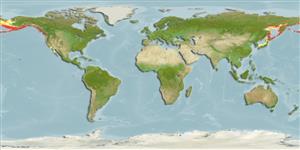分类 / Names
俗名 | 同种异名 | Catalog of Fishes(属, 种) | ITIS | CoL | WoRMS | Cloffa
Teleostei >
Salmoniformes (Salmons) >
Salmonidae (Salmonids) > Salmoninae
Etymology: Oncorhynchus: Greek, onyx, -ychos = nail + Greek, rhyngchos = snout (Ref. 45335).
More on author: Walbaum.
Environment: milieu / climate zone / depth range / distribution range
生态学
海洋; 淡水; 半咸淡水 底中水层性; 溯河洄游 (Ref. 51243); 深度上下限 0 - 250 m (Ref. 50550), usually ? - 61 m (Ref. 96339). 温带; 0°C - 24°C (Ref. 35682); 67°N - 24°N, 130°E - 110°W (Ref. 117423)
North Pacific: Korea , Japan, Okhotsk and Bering Sea (Ref. 1998), Arctic Alaska south to San Diego, California, USA. Asia: Iran (Ref. 39702).
北太平洋: 韩国 (参考文献 1998) ,日本, 鄂霍次克海与白令海 (参考文献 1998), 阿拉斯加州北极圈南至圣地亚哥,美国加州。 进口在德国限制 (Anl。 3 BArtSchV). 亚洲: 伊朗.(参考文献 39702)
Length at first maturity / 大小 / 重量 / 年龄
Maturity: Lm 70.0 range ? - ? cm
Max length : 100.0 cm FL 雄鱼/尚未辨别雌雄; (Ref. 559); common length : 58.0 cm TL 雄鱼/尚未辨别雌雄; (Ref. 3561); 最大体重: 15.9 kg (Ref. 40637); 最大年龄: 7 年 (Ref. 1998)
背棘 (总数) : 0; 背的软条 (总数) : 10 - 14; 臀棘: 0; 臀鳍软条: 13 - 17; 脊椎骨: 59 - 71. Distinguished by the lack of distinct black spots on the back and tail and by the presence of 18 to 28 short, stout, smooth gill rakers on the first arch (Ref. 27547). Pelvic fins with axillary process; caudal truncate to slightly emarginate (Ref. 27547). Large individuals are steel-blue dorsally, with speckles of black; silver on the sides; silvery to white ventrally. Males have tinges of black on the tips of its caudal, anal and pectoral fins. Spawning males are dark olive to black dorsally; grey-red with green vertical bars on the sides; dark grey ventrally; anal and pelvic fins with white tips. Spawning females resemble spawning males but less distinctly marked.
区别的特徵为在背部与尾部上的缺乏明显的黑色斑点而且藉由在第一个弓上有 18 到 28个短的,矮胖的,和平滑的鳃耙.(参考文献 27547) 腹鳍有腋窝的羽翼突起; 尾部的截形到边缘微凹.(参考文献 27547) 大的个体是铁-蓝色背面, 藉由黑色的小的斑点; 银色的侧边上; 银色到腹侧白色的。 在它的尾鳍、臀鳍与胸鳍的顶端上雄鱼有黑色的淡色。 生育期的雄鱼是黑的橄榄色到黑色的背面; 灰色的-侧边上红色的有绿色的纵带; 深灰色的腹地; 臀鳍与腹鳍鳍有白色的顶端。 产卵雌性与生育期的雄鱼相似但是更不极显着的。
Inhabits ocean and coastal streams (Ref. 86798). Migrating fry form schools in estuaries, remain close to shore for a few months and finally disperse to enter the sea (Ref. 1998). Epipelagic (Ref. 58426). Juveniles and adults feed mainly on copepods, tunicates and euphausiids but also on pteropods, squid and small fishes (Ref. 1998). Adults cease feeding in freshwater (Ref. 1998). Males and females die after spawning. The catch is mostly canned but also sold fresh, dried-salted, smoked, and frozen. Eaten steamed, fried, broiled, boiled, microwaved, and baked (Ref. 9988). Utilized for caviar.
栖息于海洋与海岸的溪流。 回游鱼苗在河口形成鱼群, 保持接近海岸数个月而且最后分散进入海洋.(参考文献 1998) 稚鱼与成鱼主要捕食桡脚类的动物, 被囊类,而且磷虾也捕食翼足目的软件动物,乌贼与小鱼。 (参考文献 1998) 成鱼停止觅食于淡水。 (参考文献 1998) 雄性与雌性在产卵之后死亡。 捕捉大部份被装于罐头也卖了生鲜地, 被烟熏的乾燥盐腌 , 与冷冻。 清蒸,油炸,火烤, 煮沸, 微波了, 而且烧烤了.(参考文献 9988) 用来做鱼子酱了。 这种的阿拉斯加州鲑鱼渔场已经被检定藉由海洋的总管职务会议 (http:// www.msc.org/) 当管理良好且族群能维持。
Life cycle and mating behavior
成熟度 | 繁殖 | 产卵场 | 卵 | 孕卵数 | 仔鱼
Enters freshwater during advanced stage of sexual development and spawning occurs almost immediately (Ref. 1998). Spawning occurs at depths of ~3 meters, current speeds of ~20cm/sec. near the head waters over sand and pebbles at 4-11° C water temperature. At spawning time the female excavates a hole of around 1 meter diameter and 50 cm depth before spawning can occur (Ref. 12218). Nest building is done by the female by lying on one side and lashing its tail to displace the sand and silt on the river bed. The pair then settles in the nest, mouths gape, and with rapid vibration of the pair, eggs and milt are released. The female then covers the nest. Males are aggressive and may spawn with different females; females likewise may spawn with other males and therefore builds different nests. Adults die after a week (Ref. 1998). A fish spawns 700-7,000 eggs in two to three egg releases. Eggs are ~300-3,500 per spawn. Egg size is ~6.7 mm, water temp. is 8-10°C at 60 days before hatching. Larva size is around 16 mm. Come springtime the juveniles go to the ocean and come back 3-4 years later to their exact birthplace. This fish reaches maturity in 2-4 years. Larvae are found around the spawning site, Juveniles are found around the coast. Juveniles migrate to the ocean at ~27-45 mm during February at water temperatures around 4° C (Ref. 12218).
Reproductive strategy: synchronous ovarian organization, determinate fecundity (Ref. 51846).北太平洋: 韩国 (参考文献 1998) ,日本, 鄂霍次克海与白令海 (参考文献 1998), 阿拉斯加州北极圈南至圣地亚哥,美国加州。 进口在德国限制 (Anl。 3 BArtSchV). 亚洲: 伊朗.(参考文献 39702)
Page, L.M. and B.M. Burr, 2011. A field guide to freshwater fishes of North America north of Mexico. Boston : Houghton Mifflin Harcourt, 663p. (Ref. 86798)
世界自然保护联盟红皮书 (Ref. 130435: Version 2024-1)
人类利用
渔业: 高经济性; 养殖: 商业性; 游钓鱼种: 是的; 水族馆: 公众的水族馆
工具
特别资料
下载 XML
网络资源
Estimates based on models
Preferred temperature (Ref.
123201): 1.1 - 8.3, mean 3.3 °C (based on 192 cells).
Phylogenetic diversity index (Ref.
82804): PD
50 = 0.5000 [Uniqueness, from 0.5 = low to 2.0 = high].
Bayesian length-weight: a=0.01445 (0.00751 - 0.02781), b=3.10 (2.94 - 3.26), in cm total length, based on LWR estimates for this species & Genus-body shape (Ref.
93245).
营养阶层 (Ref.
69278): 3.7 ±0.2 se; based on diet studies.
回复力 (Ref.
120179): 中等的, 族群倍增时间最少 1.4 - 4.4年 (K=0.27-0.45; tm=2-5; tmax=6).
Prior r = 0.32, 95% CL = 0.21 - 0.48, Based on 8 full stock assessments.
Fishing Vulnerability (Ref.
59153): Moderate to high vulnerability (49 of 100).
Climate Vulnerability (Ref.
125649): High to very high vulnerability (71 of 100).
Nutrients (Ref.
124155): Calcium = 15.6 [4.4, 41.3] mg/100g; Iron = 0.337 [0.168, 0.758] mg/100g; Protein = 18.4 [17.2, 19.5] %; Omega3 = 1.71 [0.78, 3.77] g/100g; Selenium = 110 [32, 369] μg/100g; VitaminA = 13.3 [4.6, 41.2] μg/100g; Zinc = 0.424 [0.266, 0.821] mg/100g (wet weight);
